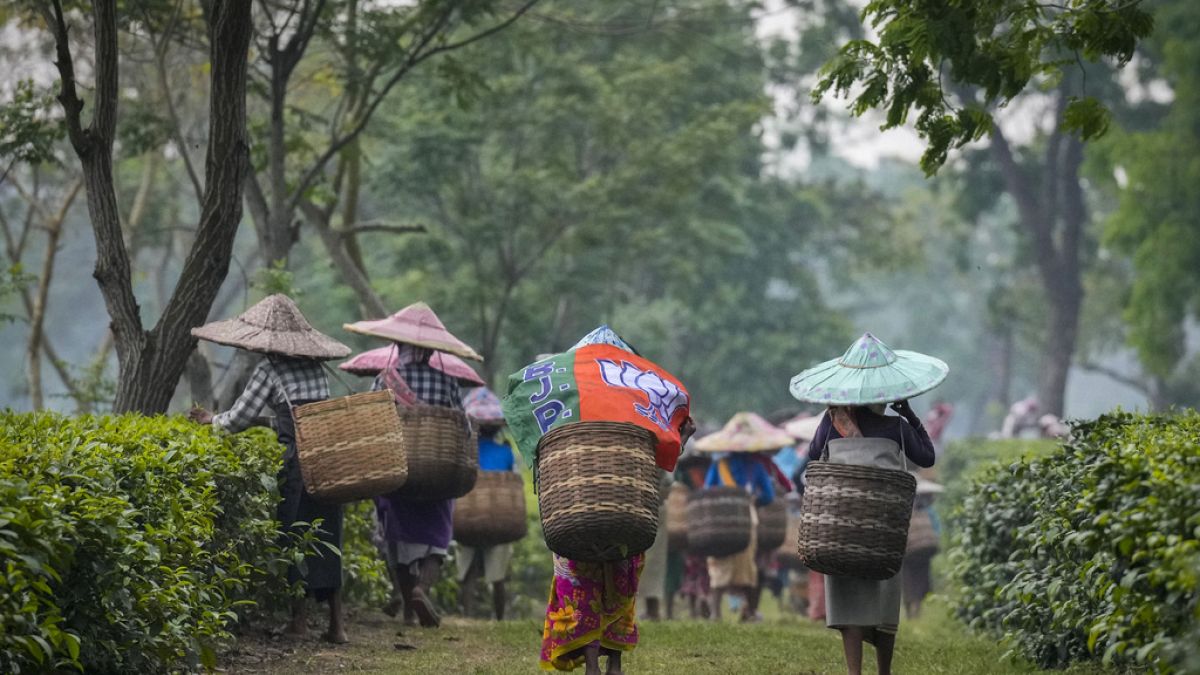Extreme weather events such as floods and droughts are especially disruptive to tea production, as the crop often relies solely on rain for its water needs, with little facilities for irrigation and water processing.
Heatwaves and floods have had a hugely detrimental impact on India’s tea production, with excessive heat in May followed by flooding in Assam hitting output level. As a result it's estimated that the average price of tea could rise by up to a fifth.
Currently, China, India, Sri Lanka and Kenya are the biggest tea producing nations globally, accounting for about 75% of worldwide supply, according to Palais des Thes.
At the time of writing, one kilogram of tea was INR 223.46 (€2.47), having risen more than 47% since the start of this year. On a year-on-year basis, tea prices have risen about 22%.
In May this year, Indian tea production dropped to 90.92 million kgs, from 130.56 million kgs in May 2023. This was the lowest May figure for the country in more than 10 years.
The Indian government’s decision to ban the use of 20 pesticides is also contributing heavily to increasing tea prices, as several buyers are once again buying Indian tea. Previously, a number of countries were rejecting Indian tea exports, due to the high amount of pesticides used in some varieties.
Some of the key buyers of Indian tea are members of the Commonwealth of Independent States (CIS), which includes Armenia, Belarus, Azerbaijan, Kazakhstan, Georgia, Moldova, Kyrgyzstan, Tajikistan, Russia, Ukraine, Turkmenistan and Uzbekistan.
Several rejections of tea exports were coming from these countries, however, following the pesticides ban, demand for Indian tea has risen once again. However, production is still suffering considerably due to this decision, with several tea growers having to scramble to find pesticide alternatives.
Extreme weather and climate change leading to subdued tea harvest
One of the major factors impacting tea production worldwide is extreme weather and the gradual effects of climate change, such as unseasonal rainfall, floods, droughts, heatwaves and frost.
Excessive rainfall, especially, is highly destructive for tea plants, which are considered to be a rainwater plant. This means that tea plantations usually depend solely on rainwater for their water needs, with little to no processing water or irrigation systems. Increased rainfall can also lead to soil and slope erosion, damaging entire plantations and leaving farmers with less overall planting area.
As a result, both in times of high and low rainfall, harvests can suffer immensely, with tea producers left with few alternative means.
Frost can also be quite dangerous for tea plants, due to leaves first drooping under the weight of frost, then eventually freezing and breaking, leading to a high percentage of lost leaves. This is often seen in Rwanda and parts of China.
Other factors dampening the crop’s production and hiking tea prices are droughts, impacting both India and China, which can often cause increased dust on the tea plants, and block sunshine. Higher temperatures can also encourage more pests which attack plants.
Further down the line, the continued effects of climate change could potentially lead to glacial lakes becoming bigger, thus decreasing growing areas for tea plantations. Similarly permafrost regions could also see more ground instability, leading to more rock avalanches and soil erosion in higher regions.
All of these would likely keep posing a risk to tea plantations and crops, either due to reduced land area, or unseasonal and extreme weather events.
Not only that, but these weather events can also cause changes in the chemical composition of tea leaves, thus changing their taste. This could lead to an unpredictable shift and decrease in buyers and tea markets as well.
Coming to what global warming will eventually mean for tea production, Arbor Teas says on its website, “Some countries (Japan in particular) have begun devising plans to address the challenges of tea production in the face of climate change. And while Japan may actually have the resources and the technological wherewithal to adapt their tea growing industry to a warmer climate, the same may not be said for other areas.
“At the end of the day, continued global warming will make growing quality teas harder and more expensive. Both the quality and quantity of production will be reduced (or at least become more erratic), and thanks to the supply and demand curve, this will mean higher tea prices for the consumer.”
Is the preservation of wild tea plants the answer?
Although the ongoing impact of climate change could seem too large to battle, there are still several ways tea farmers can protect their crops and livelihoods.
One of these is integrated weed management using herbicide-free methods such as mulch, cover crops and crop rotation, in order to replenish soil nutrients. In the long run, this can lead to better drought resistance, enhanced soil health, increased crop yields and monetary savings as well, due to less chemical fertilisers and herbicides being needed.
This can also increase productivity and help reduce pesticide use, as well as improving forest cover and reducing forest encroachment. In turn, tea flavour is also likely to be greatly enhanced.
Another way to protect tea quality is to preserve wild tea plants and agroforests. Agroforestry is a land management technique which basically combines trees with agricultural crops on the same piece of land, thus leading to crops growing in a wilder and thus, more ecologically diversified area.
Usually, agrofarmers also use far less pesticides and herbicides, choosing to let the crops grow with as little intervention as possible, rather than on carefully curated plantations. As such, these tea plants develop the resources to fight against weather changes and usually end up with higher quality leaves.
On the other hand, tea plantations which are grown as monocultures, that is, as the sole crop on a piece of farming land are usually more vulnerable to changing weather events. Agroforests are also better equipped to handle pests and uneven rainfall patterns.















